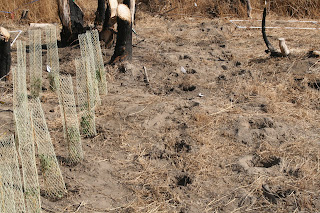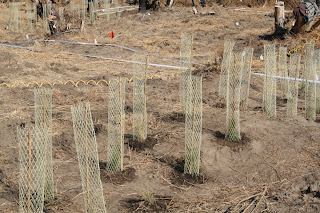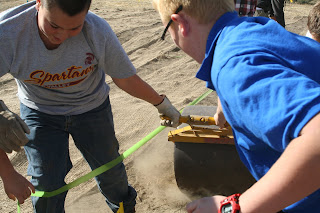Day 1: Monday 11/7/2011
Weather was perfect; no wind, enough clouds so the sun was not to hot, a high of about 60 F, following a light weekend rain.
Dr. Ken Lair, Jackie Lindgren, Matt Huffine, David Pike, about 20+/- JROTC students from the senior flight, along with a handful other students that joined periodically throughout the day worked together to:
- Auger about 1000+ holes to install 125 one gallon plants for each of 12 different species.

- Dig out each hole by hand.

- Water each hole with a 3 second burst of water from a hose (equipped with a standard garden multiple orifice attachment) attached to a portable, trailer mounted "yellow" water tank using the Quad batteries to pressurize the tank.
- Measure out a tablespoon of mycorrhizal inoculant for each hole or place a "tea bag" with mycorrhizal inoculant and plant friendly water absorbing polymer in each hole.


- Haul in on a trailer pulled by a quad 1 gallon plants that were planted in double rows of 10 each at about a two on center spacing from each other (within and between the rows). The plants were grown especially for this project by Mountain States Wholesale Nurseries in Arizona.

- Plant 1 gallon plants in sets of 4 per species around 5 foot holes filled St. Cloud zeolite (drilled with help from a crew from Pilot Rock Conservation Camp during fall break ~ 9/23 - 10/7/2011)

- Water each plant after planting with a 3 second burst of water.

- Carefully affix 3 foot tall yellow, photodegradable plastic rabbit/rodent guards around plants.
- Weave a 3+ foot bamboo stick down through the rabbit/rodent guards to anchor them into the ground.

What the study plot looked like at the start of the day 1:

And at the end of day 1:





























